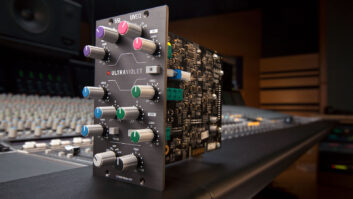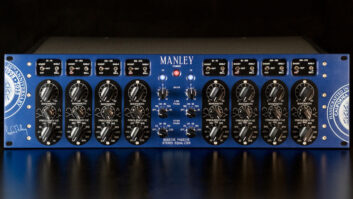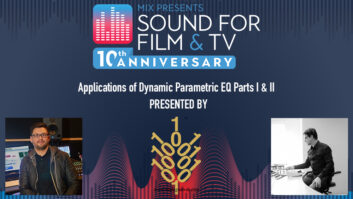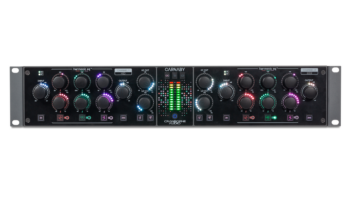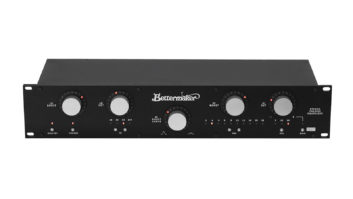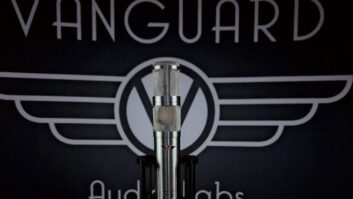

When it was released in 1999, the Manley Massive Passive EQ took the high-end pro audio world by storm. The “Pultec on steroids” design gave engineers a unique tool. The new $2,800 Langevin Mini Massive Stereo EQ is a scaled-down version of the Massive Passive and is likely to have a similar effect on the industry. I was lucky enough to borrow the big brother from Design FX in Los Angeles so that it could go toe-to-toe with our newbie.
INTERDEPENDENT CONTROLS
The front plate of the single-rackspace unit is crowded but clear. And just as you’d expect, there are switches for shelf and bell, bypass, boost and cut, as well as a power switch. Other adjustments include level (±20dB) pots for the 11 positions between 22 and 1k Hz on the low stereo bands, and another 11 between 560 and 27k Hz on the high stereo bands and variable Q control.
Traditionally, when you add +2 dB at 10 kHz and -4 dB at 1 kHz, that is what you get — more or less. However, the Mini’s passive EQ controls function much more interdependently. Most EQ bands are traditionally connected in series, while the Mini’s run in parallel, so it is better to listen to the unit’s sonic results than to glue your eyes to the front panel numbers. For example, when you cut and boost the same frequency on different bands on the same channel, they don’t cancel each other out, but rather provide another option to “shape” your EQ curve. Functions such as the bell/shelf toggle can dramatically affect the adjacent band’s response, and bandwidth settings can affect the frequency’s effective gain.
IN MY EARS
I started my listening test by A/B’ing the Massive Passive with the Mini. I opened a Pro Tools HD session and inserted the Massive on the stereo bus’ output. After matching levels with all bands bypassed, I then dialed in the high bands until I was happy.
Now with the identical setup, I switched to the Mini and copied over the EQ settings, making sure to use only the low and high bands on the Massive for a fair comparison, and recorded the Mini’s output to an outboard 24-bit/88.2kHz stereo recorder where I had also dumped an identical snippet from the Massive for an A/B comparison.
The overall tone was very close, but there were subtle differences. Mainly, I thought the mix seemed extra large with the Massive — especially on the low end. Somehow, it commanded more depth and width at identical volume.
The Mini comes standard without transformers, but they’re available as an option on the unit’s output. My review unit came with this option and I had it engaged for this part of the test, as the Massive has transformers on its outputs. As an interesting extra, not only can you bypass the Mini’s transformers, but another setting marked “vintage” exaggerates the effect of the transformer even further in an effort to emulate classic British consoles.
I tried the vintage setting on my program material, but found it too crunchy and compressed for this type of “hi-fi” audio. However, this could be fun on an amplified guitar or drum loops.
I then switched to the bypass transformer position and got a nice surprise. The extremes at the high and low end were extended and clear, and this adjustment also appeared to tighten up the low end. It would be great to have this setting on a high-res digital project or on an analog session.
Another unique Mini feature is the “Bell 2” setting on the top four frequency selections of the high bands. It narrows the Q at these settings and provides more flexibility when working on the high end.
Two other factors should be considered when comparing the Mini to the Massive, both of which are a result of the latter’s tube design: heat and noise floor. The Massive is not a noisy box, but it does have tubes while the Mini doesn’t. In my tests, the Mini was quieter and cooler.
NO SMALL CONCLUSION
Using this unit has always been a little challenging for idiots like me who normally resist cracking open the manual, but once you get the idea of the interaction between different parameters and stop “worrying” about where the pots are positioned, you can have some fun with the box. It also amazes me that what in the beginning seem to be subtle changes to program result in something very dramatic when you hit the bypass on both these units.
As I continued to go back and forth between the units, the strengths of each became more obvious. The Massive has character, warmth and puts the “p” in “phat.” The Mini is open, clean, punchy and tight. One of the design team’s goals was to provide an updated version of this unit that is better suited for mastering rooms and stereo bus applications. My experiment both succeeded and failed. I know people who will find the Mini perfectly suited for these situations, but I can imagine that some mastering engineers would rather have the Massive pried “from their cold, dead hands.”
If you want the engineering equivalent of hitting 755 home runs or winning “Le Tour,” the Massive cannot be replaced. If you want to run a “clean” race, or if money, rackspace and heat are considerations, the Langevin Mini Massive is not a compromise, but the logical alternative.
Manley Laboratories, 909/627-4256, www.manleylabs.com.
David Rideau is a Los Angeles-based recording engineer/producer.

WATCH: Bandwidth affecting the Langevin Mini Massive bell and shelf curves

Bell curve

Shelf curve
